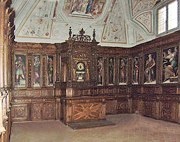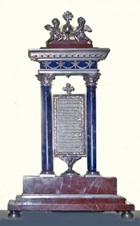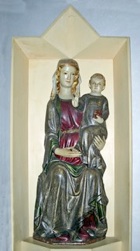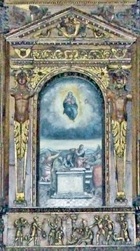This chapel stands on the site of the tribune of the ancient church of San Primiano, and the crypt of this ancient church survives below it. The chapel was initially known as the "sacrastia nove della cona" and was built to provide a fitting location for the SS Icone, a venerated icon of the Virgin. This was displayed in the tabernacle at the centre of the back wall until 1668, when it was translated to the Cappella della SS Icone.
By 1711, the chapel was known as the Cappella delle Reliquie because it housed a number of reliquaries that Cardinal Fausto Poli had donated to the Duomo in 1641. (Poli, who came from Cascia in the diocese of Spoleto and was close to Pope Urban VIII, made the donation two years before he became a cardinal.)
Madonna and Child (14th century)
This polychrome wooden statue is attributed to the Maestro di Fossa. His autograph works from the church of Santa Maria ad Cryptas, Fossa (in the province of Aquila) include an almost identical figure known as the Madonna di Fossa, which is preserved in its original tabernacle in the Museo Nazionale d' Abruzzo.
The work is a rare survival from the pre-Barberini era in the Duomo, and was first documented here in the 19th century. Silvestro Nessi (referenced below) has suggested that it came from Santa Maria di Turrita, Montefalco. A very similar statue was documented there in 1726, at which time it was “restored”. The effects of a poor restoration were removed from the statue in Spoleto in 1991-2. (The painted panels that probably closed the niche in which the statue in Santa Maria di Turrita was kept were certainly moved to the Duomo, Spoleto in 1837. They were subsequently returned to Montefalco and are now in the Pinacoteca there).
Inlaid panels (1485-7)
These panels at the corners of the back wall are the only surviving remnants of the choir in the apse, which was carved by Fr Giovanni da Verona. [When was the choir demolished ?] The surviving panels were inserted here in the 1930s.
Other inlaid wooden panels (1545-54)
The relics of this chapel were kept in in carved, inlaid wooden chests by Giovanni Andrea di Ser Moscato, Damiano di Mariotto and Lorenzo Ciampichito. The chests were dismantled in the 1930s and their front panels were used to line the walls of the chapel. This work also included the ornate gilded wooden tabernacle that housed the SS Icone until 1668.
Panels (1557)
The front panels of the reliquary chests (above) are decorated with painted figures of prophets and sibyls by Francesco Nardini.
Frescoes (1557)
The frescoes on the ceiling, which are by Francesco Nardini, depict scenes from the life of the Virgin.
Reliquary of St Vitalis (1597)
This reliquary [where is it ?] contains the tibia of St Vitalis. The inscription records that Bishop Paolo Sanvitale commissioned it after he had translated the relics of St Vitalis from San Lorenzo, Terzo la Pieve to the Duomo in 1597. (Part of the inscription recording the discovery of the relics in the 4th century, which was translated at the same time as the relics themselves, is now in the Museo Diocesano).
Read more: The theory about the origin of the statue of the Madonna and Child summarised above comes from S. Nessi, “La Chiesa di Santa Maria di Turrita”, (1999) Montefalco
Return to the page on the Interior.
Return to Monuments of Spoleto.
Return to Walk I.







